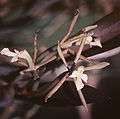Coilostylis
| Coilostylis | |
|---|---|
 | |
| Scientific classification | |
| Kingdom: | Plantae |
| (unranked): | Angiosperms |
| (unranked): | Monocots |
| Order: | Asparagales |
| Family: | Orchidaceae |
| Subfamily: | Epidendroideae |
| Tribe: | Epidendreae |
| Subtribe: | Laeliinae |
| Genus: | Coilostylis (Raf.) Withner and P. A. Harding (2004) |
| Species: | See text |
Coilostylis, was split off from the "supergenus" Epidendrum in 2004. This genus features pseudobulbs, large bracts around the flowers, and flowers that are typically resupinate, with the trilobate lip adnate to the column and having a long thin midlobe. It is not unusual for this genus to produce keikes.
Species
- C. ciliare, recognized by Kew as E. ciliare, is the type species of Coilostylis
-

C. ciliare, complete plant mounted on tree fern
-

C. ciliare, flowers
-

C. ciliare
flower
French Guiana
- C. claviata is native to Costa Rica. In the opinion of Kew, the name of this taxon is E. purpurascens
-

C. claviata plant from Suriname, as E. purpurascens
-

C. claviata flowers from Suriname, as E. purpurascens
- C. cuspidata, formerly E. cuspidatum is often confused with C. ciliare.
- C. falcata is a lithophyte from Mexico. The leaves are "sicle shaped," hence falcata. A picture may be found at
http://www.abundaflora.com/epi_falcatum.htm
- C. lacertina, formerly E. lacertinum. Harding has contributed a photo which can be found at The Internet Orchid Species Photo Encyclopedia.[1]
- C. oerstedii, formerly E. oerstedii, native to Costa Rica and Panama, has green-white flowers and a diamond-shaped elongated midlobe on the lip. Although sometimes cited as Epidendrum ciliare var oerstedii, the lateral lobes of the lip are not ciliate. A nice picture can be found at
http://www.orchidspecies.com/coiloerstedii.htm
- C. parkinsoniana, formerly E. parkinsonianum has fragrant flowers which closely resemble but are much larger than the flowers of E. nocturnum, the type species of Epidendrum. Some pictures can be found at http://www.acao.cat/wiki/index.php?title=Coilostylis_parkinsoniana&redirect=no
- C. vivipara (Lindl.) Withner & P.A.Harding, formerly E. viviparum, has fusiform pseudobulbs bearing two leaves, membranacious bracts as long as the ovary, and unfringed lateral lobes of the lip. This species was named for its habit of producing many keikeis. A photo of a plant, with a flowering keikei, can be found at
http://www.orchidspecies.com/orphotdir/epipurpurescens.jpg A digitized version of the original publication in Ewdwards's Botanical Register can be found on page 10 (after the plates) of http://www.botanicus.org/item/31753002748405
Acceptance
Althouogh the existence of the taxon Coilostylis is hard to deny, there remains some debate about its rank: is this a genus, subgenus, section, or subsection? A brief summary of recent thought (since the publication of The Debatable Epidendrums) is provided.
In January, 2005, The Royal Botanic Gardens, Kew, published Orchid Research Newsletter Number 45, announcing that Volume 4 of Genera Orchidacearum was being sent to the printers. This Newsletter listed the new assignment of species to Coilostylis. (This reference can be found at http://www.kew.org/herbarium/orchid/orn45.pdf)
As recently as December 2007, The RHS Orchid Hybrid Registration Authority was still calling Coilostylis vivipara by the name "Epidendrum viviparum Lindl." In the same issue of Orchid Review, the RHS announced that the changes in Volume 4 of Genera Orchidacearum were now reflected in new registrations. (This reference can be found at http://www.rhs.org.uk/NR/rdonlyres/EB660871-3BBF-43B1-8DB6-5ECF714E7C7F/0/orrevMar08.pdf)
Sources
- Withner, C. A. and Harding, P. A., Cattleyas and Their Relatives. The Debatable Epidendrums Timber Press 2004.